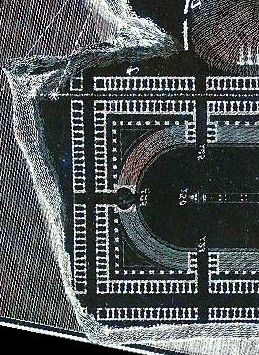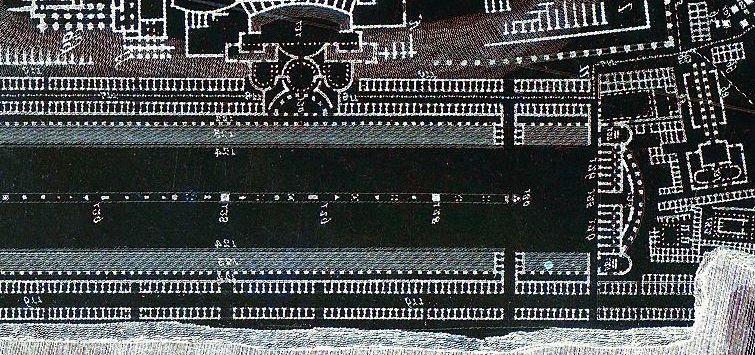10. "Villa Adriani" General plan of the breath of this villa of an extent of several miles. Another plan of the interior level of his buildings. Plans, divisions and details of all the other buildings remarkable for the elegance, the variety, the very oddity of invention in architecture. The Emperor Hadrian had these monuments executed on the model of what he had noticed most beautiful in Egypt, in Greece; he gave them the Greek names of Prytanée, Pécile, Canopi, etc. It is in this same villa that he brings together the magnificent monuments in sculpture, architecture, in precious marble, the fruit of his conquests and his trips. Also the Villa Adrienne will always be an abundant source of ancient monuments of a generally recognized richness and usefulness.
11. William L. MacDonald and John A. Pinto, Hadrian's Villa and Its Legacy (New Haven, CN: Yale University Press, 1995), p. 257.
12. And speaking of "curious and interesting work," I found the Calcographie des Piranesi, ou, Traite´ des arts d'architecture, peinture et sculpture : de´veloppe´s par la vue des principaux monumens antiques et modernes 6 June 2022 on a "francesco piranesi" search at archive.org, specifically seeking information on Francesco's 'Icnografia del Circo de Caracalla fuori della Porta Capena in oggi S. Sebastiano.' A copy of the Calcographie des Piranesi from the Getty Research Institute is among the first search results. I dimly recognize the book from many previous "piranesi" searches, but never looked inside the book before. It's all text, no images. Unfortunate, but luckily I think to do a text search of the word "caracalla," and that's when I find an actual text, in French, all about the enigmatic, unsigned site plan of the Tomb of Romulus and the Circus of Maxentius, otherwise "commonly known as Caracalla." Then, after reading the translated text, and even laughing because of the last sentence, "Curious and interesting work," it later dawns on me that those are the words of Giovanni Battista Piranesi himself. Eureka, but now what's curious and interesting is the non-existence of mention of or reference to the Calcographie des Piranesi, ou, Traite´ des arts d'architecture, peinture et sculpture : de´veloppe´s par la vue des principaux monumens antiques et modernes in Scott 1975, Wilton-Ely 1978, MacDonald and Pinto 1995 (who even confidently contemplate an intented Villa Hadriani publication project, which the Calcographie des Piranesi succinctly describes), and Minor 2015 (who writes profoundly of Piranesi's lost words, yet never found Part II of Calcographie des Piranesi, ou, Traite´ des arts d'architecture, peinture et sculpture : de´veloppe´s par la vue des principaux monumens antiques et modernes which is essentially Piranesi's dying wish list).
13. Laura Piranesi, the eldest of Piranesi's five children, turned 24 years of age in 1778. The nimbleness of Laura's confident etching abilities impressed Piranesi to no end. The summer of 1778 turned out to be a time of special bonding between Laura and her father, and Piranesi was a very proud father of Laura.
14. Francesco Piranesi, the second oldest of Piranesi's five children, turned 20 or 21 years of age in 1778.
| |
20 June 2022
Assigning a date to the "Caracalla" plate requires educated guesswork. Piranesi's description of the 'Circus of Caracalla' in the Calcographie des Piranesi suggests the beginning of a work in progress, whereas, the description of the Villa Adriani,10 also in the Calcographie des Piranesi, suggests a project well underway. 1777 is the date of Piranesi's preparatory plan drawing (now in Naples) of Hadrian's Villa, and "shortly before his death in 1778 [November 9] Giovanni Battista Piranesi supervised the transfer, by means of tracing, of the Naples drawing to the copper plates from which the Pianta were
| |

|
printed."11 If, as the respective texts in the Calcographie des Piranesi suggest, work on Hadrian's Villa predates work on the Circus of Caracalla, then Piranesi may well have commenced field survey work, one last time in the spring of 1778, at the (so-called) Circus of Caracalla site, and the "Caracalla" plate was etched by the summer solstice, when Piranesi asked for the "Pianta dell antico Foro Romano" and three of the "Ichnographia Campus Martius" copper plates to be brought to his work tables. Thus commencing more "curious and interest work."12
21 June 1778
Piranesi's highly irregular intention to erase all his previously etched circus plans and then redraw them to match the plan configuration of "Caracalla" baffled the entire workshop. Laura13 and Francesco even wondered as the rightness of their father's mental state. Yet Piranesi simply explained how the earlier circus plans proved to be discreditable and must be corrected posthaste. The copper plate areas needing erasure were not terrible large, 24 square inched at most, but the minute and fine nature of the existing line work requires a continued, fully concentrated removal effort--a task falling to Piranesi and Laura, she doing the scrapping and he right beside her doing the burnishing, while Francesco carries out further field survey work gathering data to facilitate the imminent corrected circus plan designs. A wholly unanticipated "ancient circuses" publishing project is now underway.
27 June 2022
The assimilation of counteractive knowledge led to the purge of misconceptions, and the critically necessary destructive tasks of scraping and burnishing metabolized seven elegant circus plans, seven unique Piranesi designs, to near oblivion, thus making way for ensuing corrective creations. Unlike damnatio memoriae, however, "memories" remain in the already-printed first versions of the plans, indeed memories from when Piranesi first etched the circus plans flooded
|
| |


Above top: Actual size facsimile representation of the Circus Maximus plan within the 'Pianta dell antico Foro Romano' copper plate before the 1778 scraping and burnishing erasure. Above: Actual size facsimile representation of the Circus Hadriani plan within the 'Ichnographia Campus Martius' copper plate before the 1778 scraping and burnishing erasure.
15. Mario Bevilacqua, "Piranesi 1778. Ricerche interrotte, opere perdute" in V. Cazzato, S. Roberto, M. Bevilacqua (a cura di), Il teatro delle arti. Saggi in onore di Marcello Fagiolo per 50 anni di studi, II, Roma, Gangemi 2014, p. 771.
16. Jonathan Scott, Piranesi (London: Academy Editions, 1975), p. 254.
17. John Wilton-Ely, The Mind and Art of Giovanni Battista Piranesi (London: Thames and Hudson, 1978), p. 117.
| |
his mind as Laura and he executed their erasure. Piranesi's ichnographic design skill was at its prime when the Circus Maximus plan within 'Pianta dell antico Foro Romano' was initially etched, and all the quondam circus plans within the 'Ichnographia Campus Martius' further exhibited Piranesi's design maturity. Each circus plan was perfectly fine, except for its symmetry.
...could then turn into a compelling spy-story of international intrigues: Piranèse-mystère: The secret of the missing manuscripts...
--Mario Bevilacqua, Piranesi 1778. Ricerche Interrotte, Opere Perdute15
|
3 July 2022
Last Sunday I decided to find out whatever I could about Piranesi's activities in 1778. Scott deduces Piranesi, along with Francesco, Mori and Rosa, went to Naples and Paestum one last time late 1777 or spring 177816, yet Wilton-Ely finds the evidence to support exactly such a group journey meager17. The date of such
|
|


